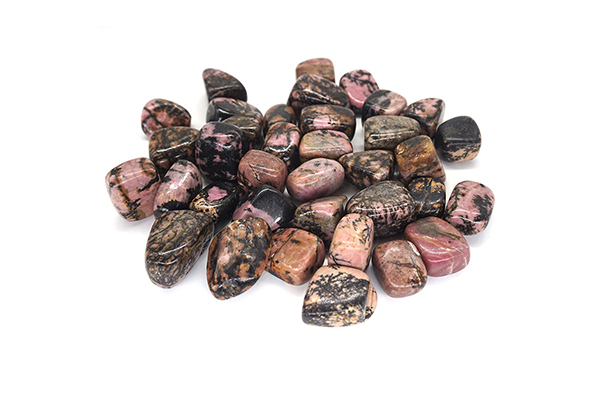Rhodochrosite and rose quartz are two popular gemstones that share some similarities in appearance but are distinctly different from each other. While both stones are known for their soft, pink hues, they differ in terms of physical characteristics, metaphysical properties, and uses. In this article, we will explore the differences between rhodochrosite and rose quartz in detail.
Physical Characteristics
Color and Translucency
Rhodochrosite is a mineral that ranges in color from light pink to deep red. It is often banded with shades of white, cream, and brown. Rhodochrosite has a translucent to transparent appearance and is prized for its beautiful pink hues.
Rose quartz, on the other hand, is a variety of quartz that ranges in color from pale pink to dark rose. It has a milky translucency, which can vary depending on the quality of the stone. Unlike rhodochrosite, rose quartz is not banded.
Crystal Structure
Rhodochrosite has a trigonal crystal system and is typically found in the form of stalactites or stalagmites. It has a distinct cleavage and is often formed in rhombohedral crystals. The crystals of rhodochrosite are relatively soft and can be scratched by a steel knife.
Rose quartz, on the other hand, has a hexagonal crystal system and is typically found in the form of massive aggregates or prismatic crystals. It has no cleavage and is relatively hard, scoring a 7 on the Mohs scale of mineral hardness.
Hardness and Durability
Rhodochrosite is a relatively soft mineral, scoring between 3.5 and 4 on the Mohs scale of mineral hardness. It is not a durable stone and can easily be scratched or damaged. It is also sensitive to heat and acids.
Rose quartz, on the other hand, is a much harder and more durable stone. It scores a 7 on the Mohs scale of mineral hardness, making it suitable for use in jewelry and other decorative items.
Occurrence and Geographic Locations
Rhodochrosite is found in a variety of locations around the world, including Argentina, Peru, South Africa, and the United States. The largest deposits of rhodochrosite are found in Argentina.
Rose quartz is also found in many locations around the world, including Brazil, Madagascar, South Africa, and the United States. The largest deposits of rose quartz are found in Brazil.
Metaphysical Properties
Historical and Cultural Significance
Both rhodochrosite and rose quartz have a long history of use in jewelry and other decorative items. In ancient times, these stones were believed to have healing properties and were often used in rituals and ceremonies.
Rhodochrosite was particularly popular among the Incas, who believed that it was the blood of their ancestors turned to stone. They used it to make jewelry and other decorative items.
Rose quartz was also highly prized in ancient times. The Greeks and Romans believed that it had the power to bring love and happiness to those who wore it. It was also used in traditional Chinese medicine to treat a variety of ailments.
Healing Properties and Uses
Rhodochrosite is believed to have a number of healing properties. It is said to promote emotional healing and relieve stress and anxiety. It is also believed to be helpful in treating respiratory issues and digestive problems.
Rose quartz is also believed to have a number of healing properties. It is said to promote love and harmony and to help heal emotional wounds. It is also believed to be helpful in treating skin problems and reducing the appearance of wrinkles.
Emotional and Spiritual Properties and Uses
Rhodochrosite is often associated with the heart chakra and is said to help heal emotional wounds and promote self-love and compassion. It is also said to help balance the emotions and promote a sense of inner peace.
Rose quartz is also associated with the heart chakra and is said to help open the heart to love and compassion. It is believed to promote feelings of self-love and acceptance and to help heal emotional wounds and promote forgiveness.
Differences Between Rhodochrosite and Rose Quartz
Color and Translucency
Rhodochrosite is typically a deeper shade of pink and has a translucent to transparent appearance. Rose quartz, on the other hand, is typically a lighter shade of pink and has a milky translucency.
Crystal Structure and Formation
Rhodochrosite has a trigonal crystal system and is typically found in the form of stalactites or stalagmites. Rose quartz, on the other hand, has a hexagonal crystal system and is typically found in the form of massive aggregates or prismatic crystals.
Hardness and Durability
Another key difference between rhodochrosite and rose quartz is their hardness and durability. Rhodochrosite is a relatively soft mineral, scoring between 3.5 and 4 on the Mohs scale of mineral hardness. It is not a durable stone and can easily be scratched or damaged. Rose quartz, on the other hand, is much harder and more durable, scoring a 7 on the Mohs scale of mineral hardness.
Metaphysical Properties and Uses
Rhodochrosite is often associated with emotional healing and is said to promote self-love and compassion. Rose quartz, on the other hand, is often associated with love and relationships and is said to promote feelings of love, harmony, and forgiveness.
Conclusion
Rhodochrosite and rose quartz may share some similarities in appearance, but they are distinctly different stones with unique physical characteristics, metaphysical properties, and uses. Whether you are drawn to the soft, pink hues of rhodochrosite or the milky translucency of rose quartz, both stones offer a range of benefits for those who seek to connect with their inner selves and promote healing and balance in their lives.If you are looking for some high-quality and affordable wholesale gemstone jewelry, you can visit JewelleryWholesaleChina.com.




